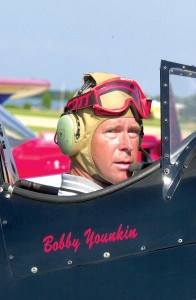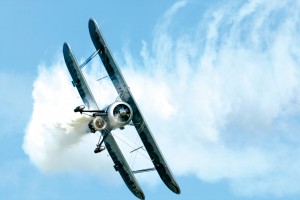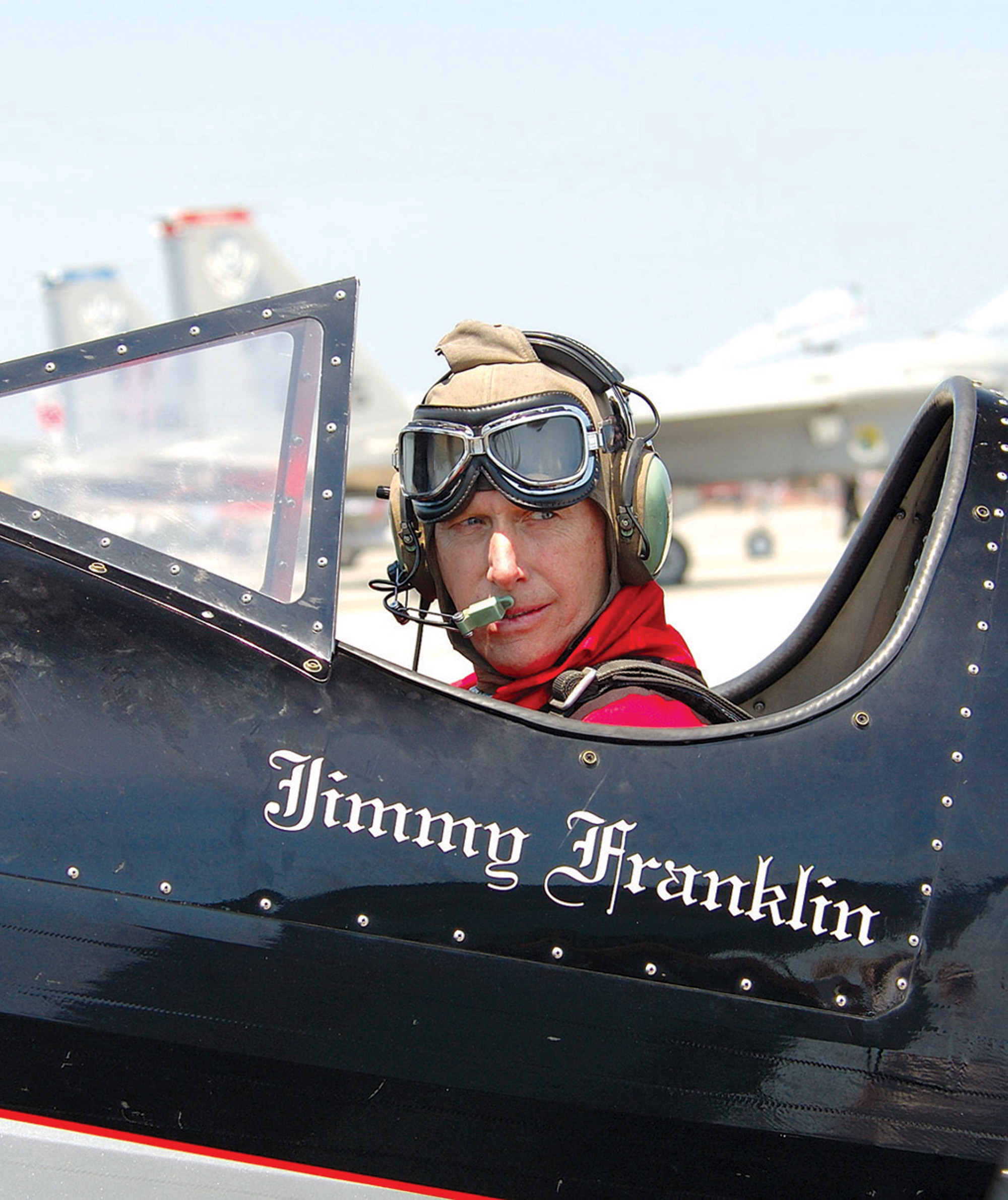By S. Clayton Moore

Jimmy Franklin appeared in films including “Forever Young,” “Terminal Velocity” and “The Rocketeer.”
Aviation enthusiasts around the world are still feeling the shock waves from the loss of two of its best. Jimmy Franklin and Bobby Younkin, who performed some of the country’s most popular air show routines, were lost in a midair collision on July 10 at the Saskatchewan Centennial Air Show in Moose Jaw, Canada.
The two pilots were performing their most popular routine, “Masters of Disaster,” which they had been performing for about five years, along with their friend and partner Jim LeRoy. All were members of the X-Team acrobatic group, which was formed in 2002.
“The Masters of Disaster show was about the wildest show I’ve ever seen,” observed Bob Bell, who worked with Younkin for more than 25 years.
The act involved a whirling biplane dogfight between Franklin, flying his signature jet-modified Waco, Younkin in his “Samson” 1940 Pitts and LeRoy in his “Bulldog S2S prop, followed by an air-to-ground fight with Les Shockley’s jet-powered “Shock Wave” truck, which shot flames into the sky. During the dogfight, something went wrong when one of the planes came up suddenly during the act and collided with the other. No spectators were injured.
While their performance looked like a turbulent hornet’s nest from the ground, the pilots always followed strict rules of engagement to keep it safe, according to LeRoy, who managed to land safely following the incident. “Masters of Disaster” had started as a dogfight act and over the past few years had evolved into a complex yet loosely choreographed act that was different every time it was performed.
The Younkin family lays no blame at the hands of any of the pilots involved.
“It was just one of those freak things,” said Younkin’s son Matt following the incident. “There’s nobody to blame, because it just happened. It was just his time to go. We wish it hadn’t happened, but we’re glad he went doing something he loved. He’s still here watching over us and he always will be.”
The incident was a terrible blow to air show participants and enthusiasts around the country, who had nothing but praise for the two pilots and their extraordinary abilities.
“Those guys put on probably the most fantastic air show I’ve ever seen,” said Ray Boudreaux, airport director at Fayetteville Municipal Airport, Younkin’s home stomping ground. “They were tops in the field.”
Services for the two pilots were held in July, including a public service at the Arkansas Air Museum at Drake Field.
In addition, several tributes were held during EAA AirVenture Oshkosh 2005, where a missing man formation was flown to the sound of “Taps” by the AeroShell Aerobatic Team and four members of the X-Team, including Jim LeRoy. Fellow aviation legends Paul Allen and Burt Rutan stopped in the middle of a press conference to look skyward during the display.
“This is a tragic loss, as it is anytime this happens in the air show community, and our deepest condolences go out to each man’s family,” said EAA President Tom Poberezny. “Jimmy and Bobby were aerial professionals and consummate entertainers, and both of them were just great people. They were among the best in the air show community and great ambassadors for aviation wherever they entertained.”
The accident struck home particularly hard for fellow acrobatic pilots like Patty Wagstaff.
“Jimmy Franklin and Bobby Younkin were friends and family,” Wagstaff said in a statement. “We loved and respected them. We’ll miss them but they will always be here. They were two of the best pilots I’ve ever seen and there will never be anyone like them. They lived awesome lives.”
In a bittersweet new beginning to the story, the Younkin and Franklin families are uniting in another way. Jimmy Franklin’s son, Kyle Franklin, performed in his father’s wing-walking act and was in the announcer’s booth when the accident occurred. For several years, he has been dating Bobby Younkin’s daughter, Amanda Younkin.

Bobby Younkin, pictured here at EAA AirVenture 2004, received the World Airshow News Bill Barber Award for Showmanship.
On August 1, Kyle flew his Cub to the Younkin’s house in Fayetteville, Ark., where he emerged with a bouquet of roses and an engagement ring. Kyle and Amanda will be married in Ruidoso, N.M., on October 18, after which Kyle plans to continue in the air show business.
Jimmy Franklin
Jimmy Marshall Franklin was born to Oliver Gene “Zip” and Valerie Franklin on May 16, 1948, in Lovington, N.M., growing up on the family’s ranch and running around the local airport. He learned to fly sitting on his father’s lap and grew into a rather wild child.
One day when Franklin was 12 years old, after finishing his chores and growing bored with racing his motorcycle, he decided he’d just take out his father’s plane. Although he struggled with getting the plane out of the hangar, he managed to taxi it out and soloed for the first time. It didn’t occur to him that his father might find out until he got home.
“I had buzzed all the neighbors,” Franklin said. “My dad called and said, ‘Well, have you got your chores done?’ I said, ‘Yeah.’ He said, ‘What have you been up to?’ and I said, ‘Flying.’ I had some model airplanes that I flew sometimes. He said, ‘Oh, which one?’ and I said, real low, ‘Yours.'”
When he got out of the doghouse, his parents put him to work flying feed to cattle in the fields. That same year, he went to his first air show in Hobbs, N.M., and learned his passion for aerobatics, learning on the fly.
“I made the decision that day to become an air show pilot,” Franklin said. “From that point on, that was my goal. I bought a book Pryor had written on aerobatics, so I’d read that book and try a maneuver, and when I got it down, I’d try another one.”
He moved quickly after high school, earning his private pilot’s license at 17 and his commercial license at 18. When he was just 19 years old, he bought a 1937 Waco biplane, powered by a Pratt & Whitney R-985 radial prop engine. Taking advantage of his aerobatic prowess, Franklin developed a series of acts including “The Dueling Wacos,” the beginning of his interest in dogfighting, a dual wing-walking routine that would later incorporate his son Kyle as the circuit’s youngest wing-walker, and a “Star Wars”-inspired act featuring a science fiction character he created named “Zar.”
“We just kept developing the air show, incorporating different acts, and the next thing was the wing-walking, the motorcycle-to-plane transfer, firewall crashes, dogfights,” Franklin said.
He also made his name in the movies. Over the years, Franklin flew in dozens of films and television programs including “Terminal Velocity,” “The Rocketeer,” “Forever Young” and “Three Amigos.”
He shared with Younkin an enthusiasm for innovative and borderline fanatic modifications to aircraft. He came up with the concept of adding a jet engine on his biplane, approaching Les Shockley, creator of the “Shock Wave” jet truck, to help him make the modifications. They replaced the plane’s prop with a 450-horsepower prop and mounted a 1,550-horsepower J-85 jet engine to the Waco’s belly, accelerating the plane to more than 200 miles per hour.
“It’s got a sound all its own,” Franklin said of the jet-modified Waco. “You hear this old biplane coming and then when it goes by, all you hear is jet noise. The neat part about it is people who don’t know a thing about planes really enjoy the plane.”

Jimmy Franklin was famous for developing his “Jet Waco,” by strapping a 1,550-horsepower J-85 engine to the belly of the plane. Both engines running together could produce up to 4,500 pounds of thrust and propel the plane up to 200 mph.
He treasured his son, Kyle, who grew up around the air shows and did his first wing-walk with his father at the age of 14.
“He was my best friend,” Kyle Franklin said. “My dad went out doing what he loved. He loved the business and he loved to entertain.”
Jimmy Franklin always said that he did it all for the audience.
“When I first started flying, I flew just for myself,” he observed in 2004. “But now I fly for my fans.”
Those fans adored Franklin, widely acknowledged as one of the top five aerobatic pilots in the country. Franklin, 57, had received many awards for his efforts including the Bill Barber Award for Showmanship in 1989 as well as winning the Art Scholl Memorial Showmanship Award twice; he was the only pilot to do so.
Bobby Younkin
“My favorite thing that I ever do in an airplane is take off,” said Bobby Younkin of his chosen profession. “It’s where you defy the laws of gravity, where you break the surly bonds of earth. It just doesn’t get any better than that.”
Robert Allan Younkin was born Oct. 30, 1955, in Prairie Grove, Ark., to Jim and Catherine Younkin. He was fascinated with aircraft from the age of three, influenced by both his father and grandfather, both pilots. Later, he built remote-controlled aircraft and learned aerobatics by flying them. He learned to fly at the age of 16 and started repeating the aerobatic maneuvers he had developed with RC aircraft by doing them for real in his father’s Decathlon.
“I just had to orient myself to being in the air instead of on the ground watching,” Younkin said.
For his high school graduation, his father gave him five hours of instruction with legendary aerobatics pilot Duane Cole; by the time he turned 18, Younkin had flown in his first air show in Siloam Springs, Ark. Later, he accepted a job flying airmail, in the late 1970s, before starting a successful air charter business, Younkin Air Service, which had recently relocated to Cecil Smith Field (Siloam Springs Municipal Airport).
However, the Arkansas native’s first love was his air show performances.
“Aerobatics is kind of like an aerial circus,” Younkin said. “People come to shows to see the impossible.”
He first came to national attention when he converted a Beech 18 twin-engine cargo plane for aerobatics in 1989. The same year saw his impressive conversion of a Learjet 23 for aerobatic use, never intended for that purpose. Younkin had to get special approval from the FAA to fly the Lear, the ninth one off the line, in air shows.
“You know you’re onto a good air show act when everyone starts telling you you’re crazy,” Younkin said of his one-of-a-kind acts.
When the accident occurred, Younkin was flying “Samson,” a replica 1940s Pitts biplane. The pilot so loved the plane that when he bought an African lion cub as a companion for his family at their home in Springdale, Ark., he named the big cat after the aircraft.
Younkin, 49, was one of Jimmy Franklin’s closest friends; the pair had tremendous respect for each other’s flying abilities. He had logged more than 15,000 hours in his 30-year career and, like Franklin, had received the Bill Barber Award for Showmanship, receiving the award at EAA AirVenture Oshkosh 2004.
“I think they wouldn’t have had it any other way,” said Mike Eckels, curator of the Ozark Military Museum in Fayetteville, Ark. “They were among the very best air show pilots in the country and they loved to perform for people. They did things that other people didn’t even think about and made it look easy.”
Family and friends gathered at the First Baptist Church in Fayetteville to pay tribute.
“My dad was a Christian as well as an amazing pilot, so we have no doubt where he’s watching from now,” said Bobby Younkin’s son, Matt Younkin. “We’re praying and taking things a step at a time, but we’ll continue to be involved in aviation.”











